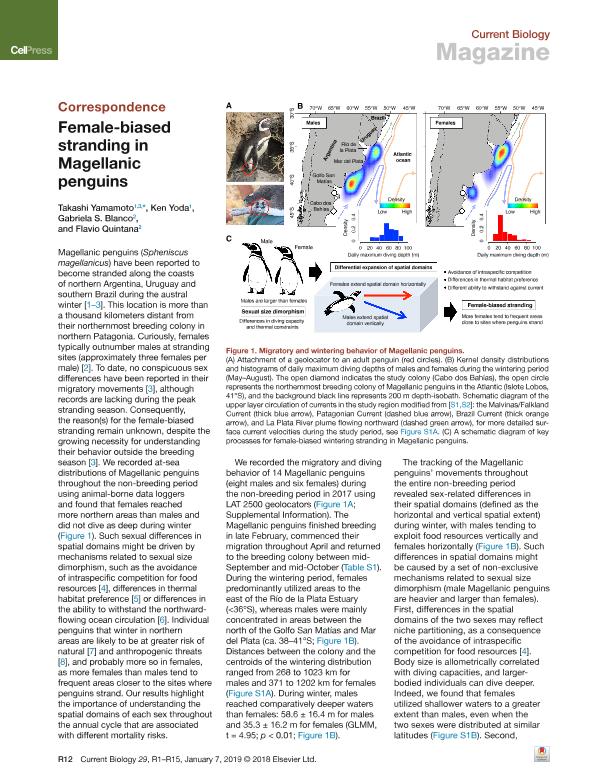Mostrar el registro sencillo del ítem
dc.contributor.author
Yamamoto, Takashi
dc.contributor.author
Yoda, Ken
dc.contributor.author
Blanco, Gabriela Silvina

dc.contributor.author
Quintana, Flavio Roberto

dc.date.available
2020-08-05T19:39:45Z
dc.date.issued
2019-01
dc.identifier.citation
Yamamoto, Takashi; Yoda, Ken ; Blanco, Gabriela Silvina; Quintana, Flavio Roberto; Female-biased stranding in Magellanic penguins; Cell Press; Current Biology; 29; 1; 1-2019; 12-13
dc.identifier.issn
0960-9822
dc.identifier.uri
http://hdl.handle.net/11336/110957
dc.description.abstract
Magellanic penguins (Spheniscus magellanicus) have been reported to become stranded along the coasts of northern Argentina, Uruguay and southern Brazil during the austral winter 1, 2, 3. This location is more than a thousand kilometers distant from their northernmost breeding colony in northern Patagonia. Curiously, females typically outnumber males at stranding sites (approximately three females per male) [2]. To date, no conspicuous sex differences have been reported in their migratory movements [3], although records are lacking during the peak stranding season. Consequently, the reason(s) for the female-biased stranding remain unknown, despite the growing necessity for understanding their behavior outside the breeding season [3]. We recorded at-sea distributions of Magellanic penguins throughout the non-breeding period using animal-borne data loggers and found that females reached more northern areas than males and did not dive as deep during winter (Figure 1). Such sexual differences in spatial domains might be driven by mechanisms related to sexual size dimorphism, such as the avoidance of intraspecific competition for food resources [4], differences in thermal habitat preference [5] or differences in the ability to withstand the northward-flowing ocean circulation [6]. Individual penguins that winter in northern areas are likely to be at greater risk of natural [7] and anthropogenic threats [8], and probably more so in females, as more females than males tend to frequent areas closer to the sites where penguins strand. Our results highlight the importance of understanding the spatial domains of each sex throughout the annual cycle that are associated with different mortality risks.
dc.format
application/pdf
dc.language.iso
eng
dc.publisher
Cell Press

dc.rights
info:eu-repo/semantics/openAccess
dc.rights.uri
https://creativecommons.org/licenses/by-nc-sa/2.5/ar/
dc.subject
MAGELLANIC PENGUINS
dc.subject
SEXUAL SEGREGATION
dc.subject
FEMALE-BIASED STRANDING
dc.subject.classification
Ecología

dc.subject.classification
Ciencias Biológicas

dc.subject.classification
CIENCIAS NATURALES Y EXACTAS

dc.title
Female-biased stranding in Magellanic penguins
dc.type
info:eu-repo/semantics/article
dc.type
info:ar-repo/semantics/artículo
dc.type
info:eu-repo/semantics/publishedVersion
dc.date.updated
2020-06-08T15:19:22Z
dc.journal.volume
29
dc.journal.number
1
dc.journal.pagination
12-13
dc.journal.pais
Estados Unidos

dc.journal.ciudad
United States
dc.description.fil
Fil: Yamamoto, Takashi. Nagoya University; Japón
dc.description.fil
Fil: Yoda, Ken. Nagoya University; Japón
dc.description.fil
Fil: Blanco, Gabriela Silvina. Consejo Nacional de Investigaciones Científicas y Técnicas. Centro Científico Tecnológico Conicet - Centro Nacional Patagónico. Instituto de Biología de Organismos Marinos; Argentina
dc.description.fil
Fil: Quintana, Flavio Roberto. Consejo Nacional de Investigaciones Científicas y Técnicas. Centro Científico Tecnológico Conicet - Centro Nacional Patagónico. Instituto de Biología de Organismos Marinos; Argentina
dc.journal.title
Current Biology

dc.relation.alternativeid
info:eu-repo/semantics/altIdentifier/url/https://www.sciencedirect.com/science/article/pii/S0960982218314891
dc.relation.alternativeid
info:eu-repo/semantics/altIdentifier/doi/http://dx.doi.org/10.1016/j.cub.2018.11.023
Archivos asociados
